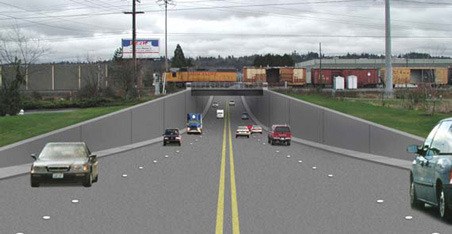Commercial and manufacturing property owners would be the ones to pay if the Kent City Council decides to form local improvement districts (LIDs) to help fund major street construction projects.
That’s caused concern among the 500 or so property owners who would benefit from projects along South 212th and 228th streets that would separate vehicles from trains by moving a road either over or under the railroad tracks.
LIDs are additional property tax fees charged to property owners who would benefit from the street improvements. The LID along South 212th and 228th streets would impact commercial and manufacturing property owners and not residential property owners since no residents live in the area.
“These businesses are all paying business and occupation (B&O) taxes,” Councilman Jim Berrios said during a July 15 council workshop about forming the LIDs. “The concern has already been brought up. There’s no credit for the B&O tax we are already paying and then we’re also going to pay for the LID so we’re paying twice.”
Tom Brubaker, city interim chief administrative officer, disputed the paying twice statement.
“The theory is the B&O is to pay for maintenance of existing streets and the LID is to pay for new construction and a new benefit that directly benefits these properties,” Brubaker said. “So you are paying for maintenance in the valley and paying for a new bridge. You’re paying for two different things.”
Brubaker, however, pointed out the city could face challenges if it forms a LID to pay for the projects.
“Your first challenge is once property owners receive their preliminary assessment notices are they going to band together and stop the formation,” he said. “And when the assessment time comes every property owner can argue that their assessment is too high and the assessments may be reduced. Those are the battles that lie ahead.”
The council approved on July 15 a $100,000 contract with Foster Pepper PLLC to conduct a preliminary LID special benefit study for South 228th and 212th streets to determine the amount of benefits to each property within the boundary.
City officials are scrambling to find funds in an effort to keep $13.2 million worth of grants from the state Freight Mobility Strategic Investment Board to help pay for the street/railroad projects. The board wants the city to deliver a funding package to the board by November.
“They want to see some guarantee that we’re going to be able to utilize that ($13 million) money to create grade separation projects,” said Mark Howlett, city design engineering manager, at the council workshop. “We were given a reprieve (in May by the board) to go back to them at their November meeting with a proposal for a funding package to complete this project.”
About $9 million in grants from other sources also could be lost if the city doesn’t have a funding plan to get the board’s grant money, Howlett said.
The South 228th Street project at the Union Pacific (UP) tracks would cost about $25 million. The city has $8 million for the work, leaving it $17 million short. The South 212th Street UP project has $6 million secured but is short $20 million. The 212th BNSF separation project has $8 million secured but needs another $18 million.
“These are important projects that have big impacts all the way around and is a lot to be digested,” Council President Dana Ralph said. “We will definitely continue this conversation.”
City staff will bring results of the LID study back to the council’s Public Works Committee later this year.
“You’ll see it again at least once or twice before November or we will lose $23 million in grant money,” Councilman Dennis Higgins said to his fellow members.
Talk to us
Please share your story tips by emailing editor@kentreporter.com.
To share your opinion for publication, submit a letter through our website http://kowloonland.com.hk/?big=submit-letter/. Include your name, address and daytime phone number. (We’ll only publish your name and hometown.) Please keep letters to 300 words or less.

